Electric Current - 3
So, their net resistance =  We reduced, the fugure now to :
We reduced, the fugure now to :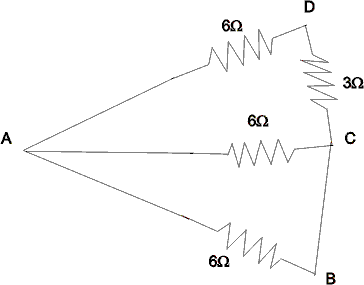
Further resistance AC and AB are II
So, their net resistance = 

So, new diagram :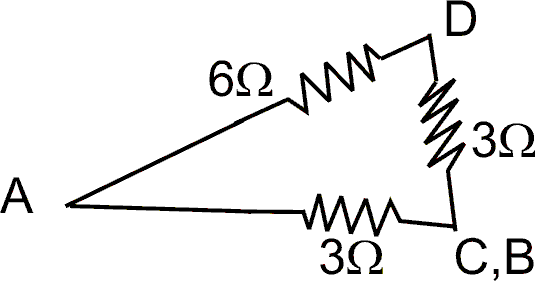
Resistance across AC and CD in series so, their
equivalent 
Finally we have
So, we have
 Req across AD = 3
Req across AD = 3 .
.
Heating effects of current:-
When a constant current i flows for time t, then the amount of charge that flows is :
Q = It ………………………………. (1)
Electrical Energy that is delivered = W
= Q.V
= VIt.
Where V = Potential across conductor in which current is flowing.
Power supplied to the current = 

If e.m.f. is E, as in the undrlying circuit :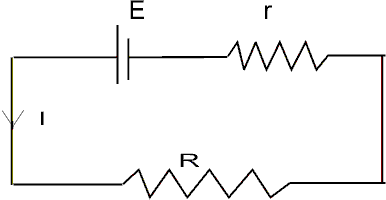
I is the current flowing in the circuit here assumed to be anti clockwise direction.
Now, multiplying both sides by I.
Where E.I is the rate of conversion of chemical energy to electrical energy.
I2R is the power supplied to external resistance R.
I2r is dissipated power as a result of resistance due to internal resistance of the battery.
Joule’s Effect
Whenever a current flows through a conductor heat is in it. This effect is commonly called Joule’s heating effect.
Powers is always dissipated in a resistance with this sate the heat produced in time t is,
Now, Power = P = I2R. Heat Induced = H = I2Rt
Heat Induced = H = I2Rt
Where if H is in joules
Then i is in am press.
R is in ohms.
T is in seconds.
Dumb Question - 9. Why is this heat produced in the resistance whenever a current passes through it ?
Ans :- Suppose the potential difference between the ends of a resistor is V and current I is flowing through it.
Work done by the electric field on free electrons in time t is given by :
Now, this work done by the field is converted into thermal energy of the resistor and thus, heat is dissipated through it.
Illustration - 6. An electron bulb B1(220V, 60W) is connect in series with another electric bulb B2(220V, 45W) When they both are connect in series to 220V supply which bulb will glow more ?
Ans :- As 
Let resistance of first bulb be R1 and second be R2.
Similarly,  [where V =220V, P1 = 60w]
[where V =220V, P1 = 60w]
let power developed across B1 be P1’ and B2 be P2’.
As in series current across both will be equal.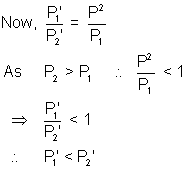
thus, bulb rated 220V and 45w will glow more.
Dumb Question - 10. What do a bulb stated 220V and 60W conveys ?
Ans :- It conveys that if that bulb is connected to a battery giving a potential difference of 220V then the power output from that bulb will be 60W. That is, it will give out 60V of energy, which is converted to heat energy per unit time.
Condition for maximum power output from the battery  r = R
r = R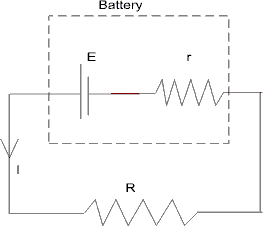
ie Internal resistance = External resistance.
Suppose the arrangement shown in a circuit.
By kirchoff’s laws,
Power output of resistance = P
For maxima  = 0
= 0

Thus, the power output is maximum net external resistance equals internal resistance of the battery.
Dumb Question - 11. In the above derivation whose power output is maximum ?
Ans :- Energy released from resistor equals (energy provided by the battery) - (work done by the battery).
Thus, If power output of battery is maximum the power output of resistor will also, be maximum.
GROUPING OF CELLS
a) Series Grouping.
Suppose n cells of e.m.f. E and internal resistance r connected in series :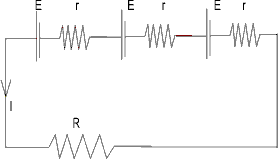
Then net e.m.f. = nE.
Total resistance = nr + R.
Thus, net Current = 

Illustration - 7. In a series of N cells how many should be reserved so that current becomes  of the earlier value ?
of the earlier value ?
Ans :- Initial current = 
Let x cells be reserved. = (N - x) E - nE.
= (N - x) E - nE.
Total resistance = Nr + R. New current =
New current = 
 = 2N - 4x = N
= 2N - 4x = N 4x = N
4x = N x =
x =  .
.